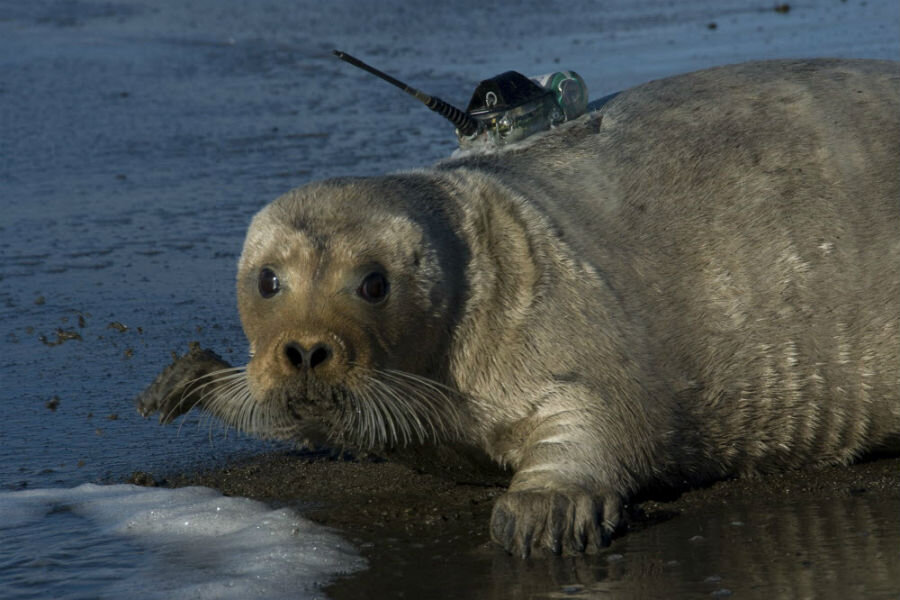With an eye on climate change, court gives bearded seals endangered status
Loading...
In a nod to the predicted impacts of climate change, an appeals court panel on Monday ruled that a certain population of bearded seals deserves endangered species protections even if they are not currently facing extinction.
The federal court decision reversed a 2014 lower court ruling. An Alaska judge then had pointed to the healthy population of seals in Alaska as evidence that the National Marine Fisheries Service's decision to give the seals an endangered status was improper and arbitrary. But the appeals court is looking forward: With current climate model projections, they say, there will be shrinking sea ice and subsequently, habitat loss that will threaten the seals’ survival by 2095.
“The Service need not wait until a species’ habitat is destroyed to determine that habitat loss may facilitate extinction,” Judge Richard A. Paez, of the Ninth U.S. Circuit Court of Appeals in San Francisco, wrote in the court opinion.
It was a historic decision that hints at the desire to protect wildlife before it is endangered rather than only preserving species after it has been decimated. Only one other species – polar bears – had been awarded the endangered species status based on climate projections, in 2008. The legal battle for bearded seals is similar to the one wrought for polar bears, and there may be more to come, some experts say, especially with other species of seals. Previous studies have also found that birds and some other animals are similarly threatened by climate change due to loss of habitat.
But such forward-looking decisions come with regulations that some affected parties find hard to justify, especially when the associated regulations clash with business activities that provide jobs in the area.
In the United States, bearded seals are only found in Alaska. According to the National Oceanic and Atmospheric Association, they are the largest species of arctic seals. While they usually hunt for food under water, they rest and give birth on ice floes. The fight to include the animal in the endangered species list began in 2008 with a Center for Biological Diversity petition followed by a lawsuit in 2009.
According to the advocacy organization, the seals’ winter sea-ice habitat in the Bering and Okhotsk seas off Alaska and Russia is “projected to decline by at least 40 percent by 2050” while summer sea ice across the Arctic will “largely disappear in the next 20 years.”
Under the Endangered Species Act of 1973, a species can be listed if it “is likely to become an endangered species within the foreseeable future.” Endangered species protections come with critical habitat designation regulations – which is where it may run into the booming oil and gas industry in Alaska.
The ruling can potentially be a blow to oil and gas drilling operations in Alaska, as reported by Alaska Dispatch News. The Alaska Oil and Gas Association (AOGA,) the American Petroleum Institute, the state of Alaska, and the governments and native corporations representing two regions in northern Alaska disagree with the ruling.
"The listing will have detrimental impacts on our ability to access Alaska's lands and resources, which is why a broad coalition - Alaska Native organizations, resource development groups, individual Alaskans and the state - came together to oppose the listing pushed by outside radical environmentalists,” Sen. Dan Sullivan (R) of Alaska said in a statement, according to the Associated Press. “I will do everything in my power to fight efforts by federal agencies to lock up our lands and resources and stifle economic opportunities for Alaskans. I hope the U.S. Supreme Court will take up the matter in the coming term should the parties decide to appeal."
Joshua Kindred, environmental counsel for AOGA, said the ruling will lead to “delays and additional costs for developers by adding an extra layer of consultation with federal agencies and perhaps new mitigation efforts,” the Alaska Dispatch News reports.
The opposing parties also argue that the research leading to the decision was not comprehensive and unscientific. But in the court opinion, Judge Paez listed studies conducted by the National Marine and Fisheries Services (NMFS) as sufficient.
“NMFS adopted the position of the overwhelming majority of the world’s climate scientists and rejected Alaska’s argument that climate projections are 'hypotheses' that are not linked to observable data and that cannot provide reasonable estimates of future climate-change-related phenomena,” he wrote.








